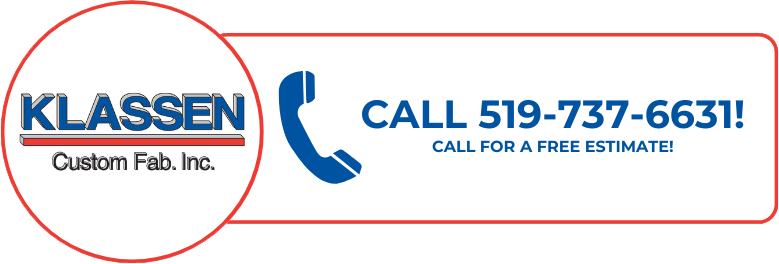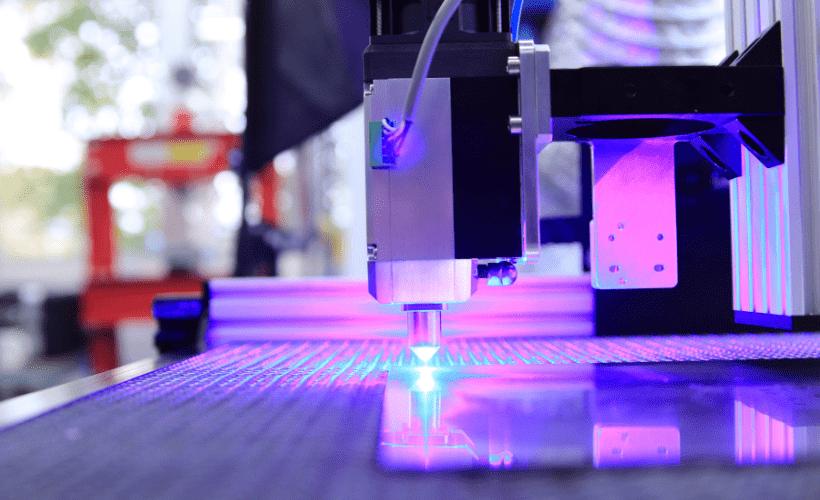In today’s competitive manufacturing landscape, precision and efficiency are not just desirable—they’re essential. Custom laser cutting technology has revolutionized the precision sheet metal fabrication industry, offering unparalleled accuracy, versatility, and cost-effectiveness for businesses across Ontario and across North America.
At Klassen Custom Fabricating, we’ve witnessed firsthand how this advanced laser cutting process transforms raw materials into precisely engineered components with exceptional precision for countless applications. This comprehensive guide on laser cutting will explore how modern laser machines can handle a variety of materials to create detailed designs with aesthetic appeal and high-quality results.
Understanding Laser Cutting Technology
Laser cutting is a thermal-based fabrication process that uses a focused high-powered beam of light to cut material with exceptional precision. During the cutting process, the laser head directs this concentrated light energy to melt, burn, or vaporize material on the material surface while a gas jet removes the resulting debris. This technology has become indispensable in modern precision sheet metal fabrication due to its remarkable accuracy and ability to create complex designs with consistent high-quality results.
Laser Types and Cutting Systems
Several laser cutting technologies and laser machines are available in today’s market, each offering specific advantages for different applications in the cutting process:
1. CO2 Laser Cutting
CO2 lasers use a gas mixture predominantly containing carbon dioxide to generate the laser beam. These systems excel at cutting non-metallic materials like wood, acrylic, and certain plastics, but they’re also effective for cutting mild steel, stainless steel, and aluminum in thicknesses up to 25mm.
Key advantages:
- Cost-effective operation
- Suitable for a wide range of materials
- Excellent edge quality on thin to medium-thickness materials
2. Fiber Laser Cutting
Fiber laser technology, a more recent innovation, uses optical fibers doped with rare earth elements to generate the laser beam. This technology has rapidly gained popularity in the metal fabrication industry due to its efficiency and precision.
Key advantages:
- Significantly faster cutting speeds than CO2 lasers
- Lower operating costs and maintenance requirements
- Superior performance on reflective metals like aluminum, copper, and brass
- Finer beam focus allowing for more intricate designs
- Energy efficiency (up to 3x more efficient than CO2 lasers)
3. Crystal Laser Cutting
Crystal lasers (Nd:YAG, Nd:YVO) use solid-state crystals as the lasing medium. While less common in general fabrication, they’re valuable for specific applications.
Key advantages:
- Excellent for engraving and marking
- Effective for highly reflective materials
- Capable of extremely fine detail work
Material Compatibility: What Can Be Laser Cut?
One of the greatest advantages of laser cutters is their compatibility with a variety of materials. Modern laser machines can process diverse materials, each responding differently to the beam of light during the cutting process. When choosing the right material for your project’s detailed designs, understanding how each material surface reacts to laser cutting is essential for achieving optimal aesthetic appeal and high-quality results.
Metals
Mild Steel
Mild steel is perhaps the most commonly laser-cut metal due to its affordability and versatility. It performs exceptionally well with both CO2 and fiber laser systems, with thickness capabilities typically ranging from 0.5mm to 25mm depending on the power of the laser.
- Optimal thickness range: 0.5mm to 25mm
- Edge quality: Excellent with minimal dross
- Post-processing needs: Minimal; may require deburring on thicker cuts
Stainless Steel
Stainless steel’s corrosion resistance makes it ideal for applications in food processing, medical equipment, and outdoor installations. Fiber lasers are particularly effective for stainless steel cutting.
- Optimal thickness range: 0.5mm to 20mm
- Edge quality: Very good with fine striations
- Post-processing needs: Potential discoloration at cut edges may require cleaning
Aluminum
While aluminum presents challenges due to its reflective properties and thermal conductivity, modern fiber lasers can cut it with remarkable precision.
- Optimal thickness range: 0.5mm to 15mm
- Edge quality: Good, typically with finer striations than CO2 laser cuts
- Post-processing needs: May require deburring; anodized aluminum requires special considerations
Specialty Metals
Other metals that can be laser cut include:
- Copper: Challenging due to high reflectivity but possible with high-powered fiber lasers
- Brass: Similar challenges to copper but achievable with appropriate settings
- Titanium: Excellent results possible with proper gas shielding to prevent oxidation
Non-Metals
While our focus at Klassen Custom Fabricating is primarily on metal fabrication, it’s worth noting that laser cutting technology is equally effective for many non-metallic materials:
- Acrylic: Creates flame-polished edges requiring no further finishing
- Wood/MDF: Produces precise cuts with some edge darkening
- Rubber: Effective for gaskets and seals
- Certain plastics: Material-specific considerations apply
Key Applications for Custom Laser Cutting Services
The exceptional precision, speed, and versatility of the laser cutting process make it an ideal choice for creating complex designs across numerous industrial applications. Precision sheet metal fabrication using laser machines offers both functional excellence and aesthetic appeal across various sectors:
Automotive Manufacturing
In the automotive industry, laser cutting produces precise components for:
- Engine brackets and mounts
- Chassis components
- Decorative trim elements
- Heat shields and gaskets
- Custom exhaust components
The technology’s ability to cut complex shapes with tight tolerances makes it invaluable for meeting the stringent requirements of automotive manufacturers throughout Windsor and the wider Ontario region.
Industrial Equipment and Machinery
For industrial machinery, laser cutting produces:
- Custom machine guards that enhance safety while maintaining accessibility
- Precision gear components
- Control panel enclosures
- Structural components requiring exact specifications
- Custom brackets and mounting plates
Architectural and Structural Projects
In architectural applications, laser cutting creates:
- Decorative metal screens and panels
- Custom railings and balustrades
- Signage and branding elements
- Structural connectors and brackets
- Custom lighting fixtures
Electrical Cabinet Manufacturing
Laser cutting excels in producing electrical enclosures with:
- Precise cutouts for switches, displays, and connectors
- Custom ventilation patterns
- Accurate hole patterns for mounting components
- One-piece construction for enhanced durability
Benefits of Custom Laser Cutting for Your Manufacturing Projects
Integrating laser cutting into your manufacturing process offers numerous advantages over traditional cutting methods:
1. Exceptional Precision in Detailed Designs
Modern laser cutting systems deliver exceptional precision with tolerances as tight as ±0.1mm. The laser head’s precise control over the beam of light ensures components fit together perfectly during assembly, reducing the need for secondary operations while maintaining the integrity of even the most detailed designs.
2. Complex Geometry and Detailed Design Capabilities
Laser cutters excel at producing intricate detailed designs and complex geometries that would be difficult or impossible with traditional cutting methods. As the laser head moves across the material surface, it can create precise contours and intricate patterns with high-quality results. This opens up new design possibilities for precision sheet metal fabrication and eliminates the need for multiple manufacturing processes.
3. Minimal Material Waste
The narrow kerf width (typically 0.1mm to 0.5mm depending on material and thickness) minimizes material waste, improving cost-efficiency for your projects. Advanced nesting software further optimizes material usage by arranging parts to maximize yield.
4. Reduced Lead Times
The speed of laser cutting significantly reduces production time compared to conventional methods:
- No need for custom tooling or dies
- Rapid transition between different designs
- Efficient processing of various materials and thicknesses
5. Exceptional Edge Quality and Aesthetic Appeal
The laser cutting process produces clean, smooth edges with high-quality results that often require minimal finishing. The precise beam of light creates cuts with excellent aesthetic appeal, reducing labor costs and accelerating production timelines while enhancing the visual quality of the finished product.
6. Design Flexibility
With laser cutting, design changes can be implemented quickly without expensive retooling, facilitating:
- Rapid prototyping
- Small batch production
- Just-in-time manufacturing
- Design iterations and customization
7. Cost-Effectiveness
While the initial investment in laser cutting equipment is significant, the technology offers compelling long-term cost benefits:
- Reduced labor costs
- Decreased material waste
- Minimal tooling expenses
- Lower secondary processing requirements
- Faster turnaround times
Choosing the Right Custom Laser Cutting Partner
When selecting a laser cutting service provider in Windsor or the broader Ontario region, consider these factors:
Equipment Capabilities
Verify that the fabricator’s laser cutting systems can accommodate your material types and thicknesses with the precision your project requires.
Quality Management Systems
Look for ISO 9001 certification to ensure consistent quality and reliable processes.
Design Support
A partner who can provide design assistance and material recommendations can help optimize your components for laser cutting.
Comprehensive Services
Consider providers like Klassen Custom Fabricating who offer complete fabrication solutions including:
- Custom welding
- Painting and powder coating
- Assembly services
- Installation capabilities
This integrated approach eliminates the need to coordinate multiple vendors and ensures consistency throughout your project.consistency throughout your project.
Contact Klassens for your Next Laser Cutting Project
Custom laser cutting technology has transformed the metal fabrication industry with its precision, versatility, and efficiency. As manufacturers face increasing pressure to produce complex components with tighter tolerances and shorter lead times, this advanced technology has become an essential capability for competitive fabrication shops.
At Klassen Custom Fabricating, our advanced laser cutting capabilities are complemented by comprehensive design, welding, finishing, and installation services. This integrated approach ensures your custom fabrication projects move seamlessly from concept to completion with the high-quality results your applications demand.
Whether you’re developing components requiring detailed designs for automotive manufacturing, industrial equipment, electrical enclosures, or structural applications, our team is ready to help you leverage the benefits of custom laser cutting for your next project. Our laser cutters can work with a variety of materials to achieve both functional excellence and aesthetic appeal.

Contact us today to discuss how our expertise in the laser cutting process can bring your most challenging fabrication projects to life with unmatched precision and efficiency.

Share This Article
Choose Your Platform: Facebook Twitter Google Plus Linkedin